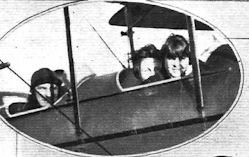|
Joy-Riding Companies |
|
|
For some years after WWI, there was a reasonable (if somewhat precarious) living to be made by offering the general public 'joy-rides'. And very popular they were too, for a while; in September 1921 Capt A F Muir (of Surrey Flying Services) said that, so far that year, he had taken up over 7,000 people, and the scarlet Avro 504K G-EBIZ owned by Messrs Hill and (Capt Percy) Phillips carried 91,000 passengers between 1924 and 1935. It seemed that anyone who could afford an ex-RAF Avro 504 could set up as an individual or a company, and try their luck. |
Capt 'Jerry' Shaw with two little girl passengers whom he took up in his golden D.H.60 Gipsy Moth G-EBQE 'Arom' at Lympne in April 1928 |
|
There was an initial 'joy-riding boom' period in England from May 1919 to March 1920; during this time, 66,785 passengers flying 'for hire or reward' (almost all of them joy-riding) were carried. Over 50 companies set up business, but the slump of 1921 put an end to easy money, and to most of these companies. In Australia, things were even more relaxed; up until November, 1920, when the Air Navigation Act was passed, pilots were free to run joy-riding concerns quite unhampered by C. of A. restrictions, or any other restrictions for that matter: "A number of unpleasant crashes was the not unnatural result." By October 1925, joy-riding still accounted for the majority of flying in England - 43,766 passengers, more than 3 times as many as the scheduled airlines - and the following year a new record was set, with 67,329 passengers. By 1928 the newly-established flying clubs were taking over most of the day-to-day work of offering joy-rides, but even so in 1930 there were still 12 companies offering 'joy-riding' in England; Australia had 6, and Canada 16. October 1930:
By the mid-thirties, though still popular, 'taxi, school and joy-riding' companies accounted for rather less than 25% of aeroplane ownership. June 1936: "A REAL OPPORTUNITY The best position on the South Coast for 'joy-riding' is for sale as a going concern. Includes machine, field (rent paid until October), motor car, and all printing and bill-posting. Pilot and ground engineer available. " |
|
|
February 1932: "Although joy-riding is, and has been, the only branch that can show a profit, it unfortunately created a table of false values for this reason. There were pilots, for instance, last year 'on tour' with joy-riding 'circuses,' who were receiving extremely good salaries. In addition to which they received a commission and their expenses. Of course, they stayed at the Grand or the 'Majestic,' made going to bed well under the surface a matter of duty, and generally putting out the boat on a pretty hefty scale. And this isn't romance, it's reality. There are certain people connected with operating companies to-day, unfortunately, who are under the impression that aviation is Nature's excuse for having a good time. Just look back into the history of joy-riding in this country, and what does one see? The whole of its field is littered with wrecks of "Aviation" firms. Wrecked for the most part by rank rotten management, and spendthrift policies. The whole trouble has been that the majority of these firms have been inefficiently run by men with little or no business experience. They operated in the blissful belief that "the weather to-morrow will be O.K.," and spent their takings up to the limit. An error of judgment and a write off, or a spell of dud weather, and there was another joy-riding company up a gum tree. Few people can realise how precariously some of these firms exist, and what a struggle it is to see the winter through. Ask some of their engineers and pilots who are given holidays, sometimes lasting from September until the next March ! Do we have to look far to see evidence of this? We do not. A great many of these people " live on the posh " during flying days, and then in the fall and 'til the next spring eke out an existence on bread and jam! Who wouldn't be an airman?" April 1935: "with a public that has, for the most part, become inured to the sight of mere flying, or even of aerobatic flying, a modern team of display pilots must be beyond criticism, and a modern display must rival, if in miniature, the great show at Hendon. Furthermore, Sir Alan Cobham's display, designed as it is to encourage people to use the air, must blend the spectacular with the commonplace so that the "circus" element is not too dominant." April 1936: "There is no doubt that the opening flying display of the year showed a number of distinctly new possibilities. Not only are the joy-riding rates lower, probably, than they have ever been before, so that more people will be encouraged to discover that there is really nothing very terrifying about this flying business, but the general public is also being shown at least a few types which might eventually appeal to them as private owners, flying lessons are being given and scholarships are being awarded to those newcomers who show the greatest aptitude." December 1937: "Within the past two years, however, the novelty has worn off the circuses and receipts from this source have dropped considerably." |
|


